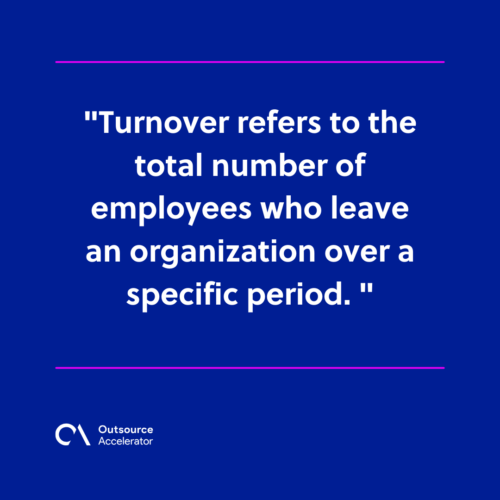Turnover vs. Attrition: Key differences and tips

Navigating the corporate landscape can feel like trying to decipher a complex puzzle.
One piece of that puzzle often discussed in boardrooms is between turnover and attrition.
While these concepts are sometimes used interchangeably, both represent distinct aspects of employee movement within an organization.
LinkedIn data revealed that HR had the highest turnover rate, at 14.6%, followed by research (13.1%) and product management (13.0%). Technical positions, including administration (7.8%), operations (8.8%), and accounting (9.4%), exhibited lower turnover rates.
In this article, we’ll delve into turnover vs. attrition, explore their key differences, and provide practical tips for managing and improving both rates.
Turnover vs. Attrition: Definition of terms
In the realm of workforce management, turnover and attrition are frequently confused, yet they differ significantly.
Let’s explore the concepts of turnover and attrition:
What is turnover?
Turnover refers to the total number of employees who leave an organization over a specific period. This departure can be voluntary (resignations, retirements) or involuntary (terminations, layoffs). Turnover rate formula
The turnover rate is a percentage that indicates the proportion of the workforce that has left during a given timeframe.
Turnover Rate= (Average Number of Employees / Number of Employees Departed) ×100
To apply the formula:
- Determine the number of employees who left (voluntarily or involuntarily) during a given time frame.
- Calculate the average number of employees during that same period.
- Calculate the ratio of employees who have left to the average number of employees.
- Multiply the outcome by 100 to represent the turnover rate as a percentage.

What is attrition?
Attrition focuses specifically on the natural reduction in the workforce due to retirements, resignations, or death. It does not include departures resulting from layoffs or terminations.
Attrition rate formula
The attrition rate is the percentage of employees lost due to natural causes.
Attrition rate = (Average Number of Employees / Number of Employees Lost to Attrition) ×100
To apply the formula:
1. Identify the number of employees who left the organization due to voluntary reasons, such as retirement or resignation, during a specific timeframe.
2. Calculate the average number of employees over the same period.
3. Divide the number of employees lost to attrition by the average number of employees.
4. Multiply the outcome by 100 to articulate the attrition rate as a percentage.

Turnover vs. Attrition: Key differences
Here are the key differences between turnover and attrition:
Time frame
Turnover often involves a relatively short time frame, with employees departing and replacements arriving swiftly. Meanwhile, attrition takes place gradually over an extended period, reflecting a more natural reduction in the workforce.
Voluntary and involuntary
Turnover encompasses both voluntary departures, such as resignations, and involuntary departures, like terminations. On the other hand, attrition primarily involves voluntary departures, typically driven by retirements or personal decisions.
Scope
Turnover has a broader scope, covering the entire process of employees leaving and being replaced. Attrition has a narrower focus, emphasizing the natural reduction in workforce numbers without immediate replacements.
Management perspective
In terms of management, turnover often requires immediate action and short-term planning to fill vacant positions promptly. Whereas, attrition allows for more strategic, long-term workforce planning, as replacements may not be urgently needed.
Causes
Turnover can be triggered by various factors, including dissatisfaction, career opportunities elsewhere, or organizational changes.
But, attrition is mainly driven by voluntary factors like retirements, resignations, or personal choices.
Tips for improving turnover and attrition rate
When it comes to managing workforce dynamics, it is crucial to focus on strategies to improve turnover and attrition rates.
Here are practical tips for fostering a positive and engaging workplace:
Employee engagement
Fostering employee engagement is key to reducing turnover and attrition. Contented and satisfied employees are more inclined to remain dedicated to your organization.
Regular check-ins, open communication channels, and recognizing achievements contribute to a positive work environment.

Competitive compensation and benefits
Ensure that your employees receive competitive compensation and attractive benefits. This will position your organization as an employer of choice.
Conduct regular market analyses to stay on par with industry standards.
Work-life balance
Burnt-out employees will consider alternatives. Balance is the key to a happy workforce. Encourage reasonable working hours, provide flexible schedules, and promote a culture that respects personal time.
Training and development
Investing in your employees’ growth pays dividends. Provide training programs, workshops, and opportunities for skill development.
When employees see a path for career advancement within your organization, they are more likely to stay.
Effective onboarding
First impressions matter. A streamlined onboarding process establishes the foundation for an employee’s journey.
Make sure new hires feel welcomed, understand their roles, and are integrated seamlessly into the team.
Health and wellness programs
A healthy employee is a happy employee. Implement wellness initiatives to show your commitment to your employees’ well-being.
Whether it’s gym memberships, mental health programs, or health check-ups, these initiatives contribute to a positive work environment.
Navigate Turnover vs. Attrition challenges swiftly
Understanding the distinctions between turnover and attrition empowers you to tackle workforce challenges effectively.
Embrace the tips outlined above to create a workplace that attracts and retains top talent. Remember, a proactive approach today ensures a stable and thriving workforce tomorrow!







 Independent
Independent




